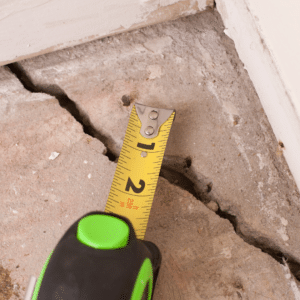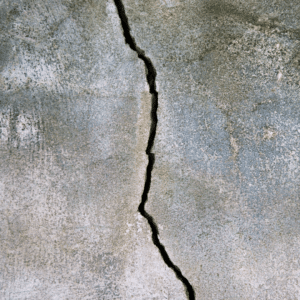
16 Nov Cracks in Your Foundations? But What Type Are They?
If you find cracks in your home’s foundations, it’s essential to get them fixed. However, they’re not all disastrous. This brief guide will give you an idea of which cracks can be repaired when it’s convenient — and which need urgent action.
1. Horizontal Cracks
Horizontal cracks in your foundations are typically caused by water pressure and may be accompanied by inward bowing and water leaking into your basement, if you have one. Horizontal cracks can be dangerous to the structure of the building, and it’s vital to call a foundations specialist right away.
2. Stair Step Cracks
If you have block foundations, either water incursion or settling can create cracks along the mortar joints. These can be both vertical and horizontal, and anything more than a hairline crack can pose a serious threat to your foundation’s integrity. It’s essential to get them looked at as soon as possible.
3. Foundation Slab Cracks
Foundation slabs can crack for various reasons. Drying and settling are the most likely causes, but it can also be the result of buckling caused by frost heave. On the other hand, poorly installed foundation slabs can crack if the ground wasn’t properly prepared. Any cracks wider than hairline should be examined and repaired as soon as possible.
4. Hairline and Shrinkage Cracks
Both hairline and shrinkage cracks in the foundations have various causes, but they’re particularly common in new builds as they settle, in particular as the concrete dries out. They can be repaired easily and inexpensively, but if your home is new, they might be covered by the builder’s warranty. Hairline cracks don’t necessarily need to be repaired at once but should be checked regularly in case they get wider.
5. Vertical Cracks
Vertical cracks, running straight up and down, are normally caused by settling over a period of time. They’re particularly common in basements. Although they’re less serious than horizontal cracks and don’t pose serious structural threats, they still need to be repaired, at least once they get beyond hairline width.
6. Diagonal Cracks
Very much like vertical cracks, diagonal cracks — typically tilted at less than 30 degrees from vertical — tend to be caused by settling. Again, they’re not a serious threat to structural integrity but should be repaired promptly if they’re any wider than hairline.
Structural or Non-Structural Cracks?
While all foundation cracks will need to be repaired, the urgency can depend on whether the cracks are structural or non-structural. The three main types are:
- Non-structural cracks, which are likely to be cosmetic and don’t threaten the foundations’ structure. However, if they’re letting water in, this can lead to damage, wet patches and health hazards such as mould or mildew.
- Wet non-structural cracks, which are most likely to happen in new foundations, due to the concrete drying. Again, the threat here is internal damp, rather than structural damage.
- Structural cracks, such as horizontal cracks or any cracks wider than a quarter of an inch. These threaten the structural integrity of your foundations, and therefore of your home. Any structural cracks need to be repaired at once.
Whether the cracks you find in your foundations are serious structural cracks or less urgent types, you’ll need to get a foundation specialist to fix them. Your home’s foundations are too vital to be left for DIY, or even a general builder.
If you’re looking for piling contractors in London, the surrounding areas or South East England, you can contact U&M to discuss your needs.










